Aircraft Maker Turns The Big 9-0
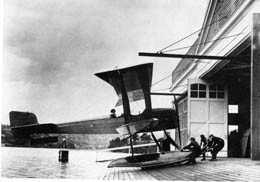 Saturday marked a
significant event in the history of commercial and military
aviation -- the 90th birthday of the Boeing Airplane Company.
Saturday marked a
significant event in the history of commercial and military
aviation -- the 90th birthday of the Boeing Airplane Company.
Founded by William Boeing and George Conrad Westervelt on July
15, 1916, "B&W" (from the men's initials) started out with 21
employees at a factory in Seattle, WA, producing wooden aircraft
structures. As was befitting an aviation company that got its start
in a boat house on the shores of Lake Union, the company's first
aircraft was a seaplane -- the B&W 'Bluebill' (right).
The company soon changed its name to "Pacific Aero Products,"
and in 1917, became simply the "Boeing Airplane Company." The
company won its first military contract in 1921.
In 1927, William Boeing created an airline -- humbly naming it
Boeing Air Transport -- and a year later, BAT merged with Pacific
Air Transport and Boeing Airplane Company to form a single
corporation. Over the next several years, this monolithic group
bought up other aviation businesses -- such as Pratt & Whitney,
Hamilton Standard propellers, and Chance Vought -- all under the
umbrella of United Aircraft and Transport Corporation.
The Air Mail Act of 1934 brought an end to airlines owning
manufacturers, though, and vice versa -- leading UATC to split into
three smaller companies -- Boeing Airplane Company, United
Airlines, and United Aircraft Corporation. All three survive today,
with the latter now known as United Technologies.
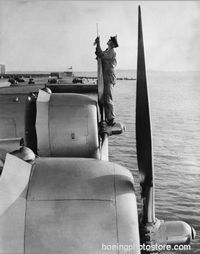 In the late 30s, Boeing
first saw big business in the production of commercial airliners --
supplying Model 314 Clippers to Pan American World Airways, later
Pan Am. The company also introduced the world's first pressurized
transport plane, the Model 307 Stratoliner, in 1938.
In the late 30s, Boeing
first saw big business in the production of commercial airliners --
supplying Model 314 Clippers to Pan American World Airways, later
Pan Am. The company also introduced the world's first pressurized
transport plane, the Model 307 Stratoliner, in 1938.
Like many American corporations, with WWII came a complete shift
in Boeing's production strategy to support the war effort. Boeing
assembled as many as 350 B-17 Flying Fortresses and B-29
Superfortresses per month by March 1944, in plants cleverly concealed to look like farms and
towns from the air. Other manufacturers, such as Bell,
Lockheed and Douglas, also built licensed versions of Boeing
designs.
Boeing was slow to recover after the war ended, however, with
commercial production barely sustained by the quick-design
Stratocruiser, a passenger-carrying version of the B-29 that saw
little sales. Fortunately, military production soon ramped up once
again, with Boeing producing versions of its planes for troop
transport, and aerial refueling.
By the 1950s, Boeing was also developing and building some of
the earliest cruise missiles... but the company was still known for
its commercial aircraft designs, an area many thought the company
was losing ground to the Europeans in by the late 1950s (sound
familiar?) with the introduction of the British De Havilland Comet
and French Sud Caravelle.
Boeing soon responded, though, with one of the most famous
airliners of all time: the Boeing 707. Customer deliveries of the
four-engined narrowbody began in 1958.
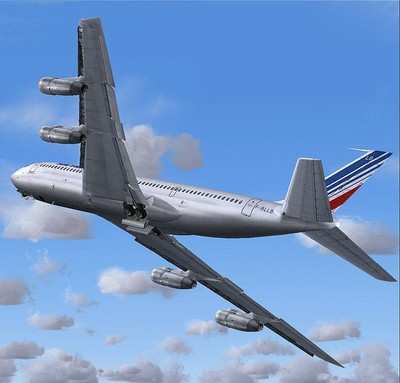
The 1960s saw Boeing expand its commercial line to the faster,
but shorter-range (and less successful) Model 720 variant of the
707, as well as the introduction of the trijet 727 short-range
airliner and the medium range 737 twinjet.
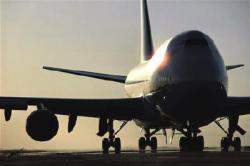 On the military side,
Boeing acquired Piasecki helicopter in 1960, renaming it Boeing
Vertol -- and leading to the CH-47 Chinook, and CH-53 Sea King
helos.
On the military side,
Boeing acquired Piasecki helicopter in 1960, renaming it Boeing
Vertol -- and leading to the CH-47 Chinook, and CH-53 Sea King
helos.
In 1970, the first customer version of the mammoth new 747 --
the largest commercial airliner in existence, until the
introduction of the Airbus A380 35 years later -- took flight, and
to this day the 747 remains (arguably) Boeing's -- and the world's
-- most identifiable airplane. On the aerospace side, Boeing saw
its lucrative NASA contract building Apollo space capsules come to
an end... as well as the cancellation of Boeing's 2707 program, the
manufacturer's proposed answer to the Concorde SST.
Even with Airbus becoming a major player in the commercial
market by the mid-1980s, Boeing still did well throughout the
decade -- producing its 1000th 737 in 1983, as well as introducing
the fly-by-wire 757 and widebody 767. Boeing was also a major
contractor for the space shuttle program, as well as the first
contractor for the International Space Station.
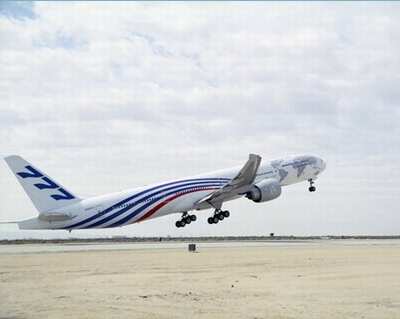
Mergers and acquisitions were the name of the game in the 1990s,
with Boeing acquiring Rockwell International in 1995, and McDonnell
Douglas in 1996. On the aircraft side, the long-range Boeing 777
("Triple Seven") was introduced in 1994, and the MD-95 airliner was
renamed the Boeing 717-200. While the 777 has been an
unquestionable success for the company, the 717 line experienced
middling sales until it was shelved in April of 2006.
Two scandals also rocked the company in recent years: the
Darleen Druyun/Air Force procurement debacle in May 2003, and the
resignation of popular CEO Harry Stonecipher in March 2005 over an
'inappropriate' relationship with a female coworker.
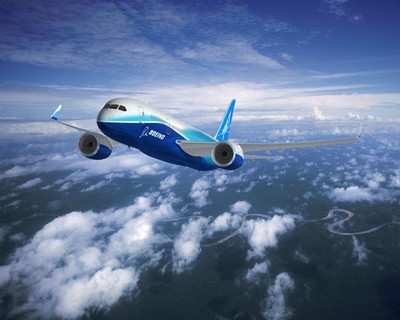
Today, however, Boeing Commercial Airplanes is enjoying a
resurgence in the marketplace, after losing the sales and
deliveries crowns to Airbus in 2003. Some of this has come at the
expense of its rival -- as Airbus currently experiences a downturn
similar to what Boeing faced in the first half of the decade --
while others point to the success of Boeing's 787 Dreamliner
program, and its reliance on weight-and-fuel-saving composite
structures.
Boeing's military and aerospace divisions are doing somewhat
less well, with the company's commercial rocket launch business
struggling to liftoff and the C-17 Globemaster III (inherited from
McDonnell-Douglas) constantly fighting for its life before
Congress.

Still... all indications are that Boeing will be around for a
long time to come... and if history is an indicator, make your
plans now for the 180th birthday celebration in 2096...
 ANN's Daily Aero-Linx (04.16.24)
ANN's Daily Aero-Linx (04.16.24) Aero-News: Quote of the Day (04.16.24)
Aero-News: Quote of the Day (04.16.24) Airborne 04.10.24: SnF24!, A50 Heritage Reveal, HeliCycle!, Montaer MC-01
Airborne 04.10.24: SnF24!, A50 Heritage Reveal, HeliCycle!, Montaer MC-01 Airborne 04.12.24: SnF24!, G100UL Is Here, Holy Micro, Plane Tags
Airborne 04.12.24: SnF24!, G100UL Is Here, Holy Micro, Plane Tags Airborne-Flight Training 04.17.24: Feds Need Controllers, Spirit Delay, Redbird
Airborne-Flight Training 04.17.24: Feds Need Controllers, Spirit Delay, Redbird








